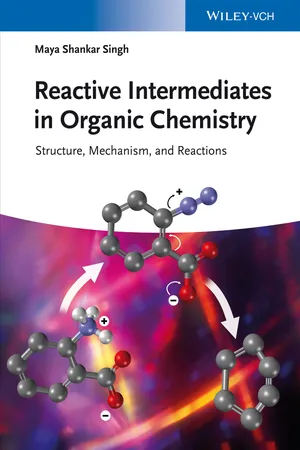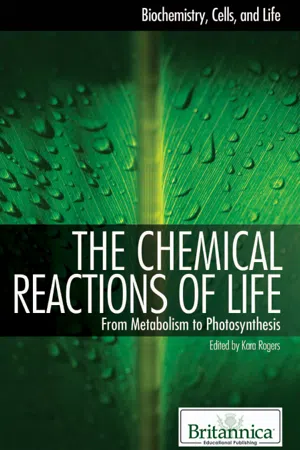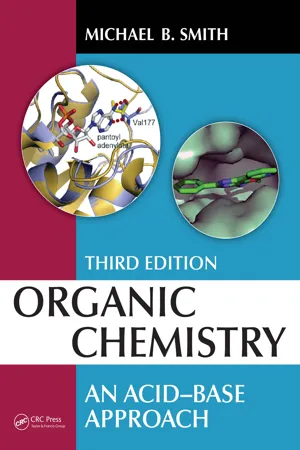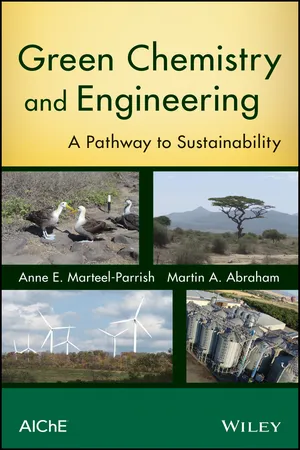Chemistry
Synthesis Reaction
A synthesis reaction is a type of chemical reaction in which two or more simple substances combine to form a more complex product. This process typically involves the formation of a single compound from its constituent elements or simpler compounds. Synthesis reactions are fundamental to the creation of various chemical compounds and materials.
Written by Perlego with AI-assistance
Related key terms
Related key terms
1 of 4
Related key terms
1 of 3
4 Key excerpts on "Synthesis Reaction"
- eBook - ePub
Reactive Intermediates in Organic Chemistry
Structure, Mechanism, and Reactions
- Maya Shankar Singh(Author)
- 2014(Publication Date)
- Wiley-VCH(Publisher)
To understand organic chemistry one must be familiar with two languages. One is the structure and representation of molecules. The second is the description of the reaction mechanism in terms of curly arrows. The first is static and the second dynamic. Synthesis is considered difficult because you need to have a grasp of lots of reactions. Well, if you have an understanding of simple basic organic chemistry plus a few special “tools” you can do a surprising amount and enjoy the challenge. A detailed understanding of reactive intermediates is at the heart of chemical transformations, and thus of modern synthetic chemistry. The term reactive further implies a certain degree of instability of the species. Reactive intermediates are typically isolable only under special conditions, and most of the information regarding the structure and properties of reactive intermediates comes from indirect experimental evidence. Reaction mechanisms are a fundamental and most important part of organic chemistry, telling us about the interaction between electron-deficient and electron-rich species. The functional group is the site of reactivity in a molecule. By looking at the structure of the functional group, it is possible to predict the kind of reactions it will undergo.A chemical reaction at the molecular level is an event in which two molecules collide in such a way as to break one or more of their bonds and make one or more new bonds, and hence new molecules. The sequence and timing of the bond-breaking and bond-making processes will be important to our understandings of the reactions. To find out how molecules react with each other and how to predict their reactions we need to know thereaction mechanism. Organic chemistry encompasses a very large number of compounds (many millions). To recognize these actors (compounds), we turn to the roles they are inclined to play in the scientific drama staged by the multitude of chemical reactions that define organic chemistry. We begin by defining some basic terms that will be used very frequently as this subject is elaborated:- Chemical reaction: A chemical reaction is a process that leads to the transformation of one set of chemical substances into another. Classically, chemical reactions encompass changes that strictly involve the motion of electrons in the forming and breaking of chemical bonds between atoms, and can often be described by a chemical equation. A transformation results in the change of composition, constitution, and/or configuration of a compound (referred to as the reactantorsubstrate) by making or breaking of carbon–carbon (C–C), carbon–hydrogen (C–H), and/or carbon–heteroatom (C–X) bond(s). Chemical reactions are described with chemical equations, which graphically present the starting materials, end products, and sometimes intermediate products and reaction conditions.
- Reactant or substrate:
- eBook - ePub
The Chemical Reactions of Life
From Metabolism to Photosynthesis
- Britannica Educational Publishing, Kara Rogers(Authors)
- 2010(Publication Date)
- Britannica Educational Publishing(Publisher)
A chemical reaction is any process in which substances are changed into different ones, with different properties. Chemical reactions involve the rupture or rearrangement of the bonds that hold atoms together. The total mass and number of atoms of all reactants equal those of all products, and energy is almost always consumed or liberated. In addition, the speed of reactions varies. In the laboratory, understanding the mechanisms of reactions enables chemists to alter reaction conditions to optimize the rate or the amount of a given product. This type of experimentation provides important insights into conditions that may affect reactions within biological systems. The reversibility of reactions and the presence of competing reactions and intermediate products complicate these studies.SYNTHESISWhen making a new substance from other substances, chemists say either that they carry out a synthesis or that they synthesize the new material. Reactants are converted to products, and the process is symbolized by a chemical equation. For example, iron (Fe) and sulfur (S) combine to form iron sulfide (FeS).Fe(s) + S(s) → FeS(s)The plus sign indicates that iron reacts with sulfur. The arrow signifies that the reaction “forms” or “yields” iron sulfide, the product. The state of matter of reactants and products is designated with the symbols (s) for solids, (l) for liquids, and (g) for gases.THE CONSERVATION OF MATTERIn reactions under normal laboratory conditions, matter is neither created nor destroyed, and elements are not transformed into other elements. Therefore, equations depicting reactions must be balanced—the same number of atoms of each kind must appear on opposite sides of the equation. The balanced equation for the iron-sulfur reaction shows that one iron atom can react with one sulfur atom to give one formula unit of iron sulfide.Chemists ordinarily work with weighable quantities of elements and compounds. For example, in the iron-sulfur equation the symbol Fe represents 55.845 grams of iron, S represents 32.066 grams of sulfur, and FeS represents 87.911 grams of iron sulfide. Because matter is not created or destroyed in a chemical reaction, the total mass of reactants is the same as the total mass of products. If some other amount of iron is used, say, one-tenth as much (5.585 grams), only one-tenth as much sulfur can be consumed (3.207 grams), and only one-tenth as much iron sulfide is produced (8.791 grams). If 32.066 grams of sulfur were initially present with 5.585 grams of iron, then 28.859 grams of sulfur would be left over when the reaction was complete. - eBook - ePub
Organic Chemistry
An Acid-Base Approach
- Michael B. Smith(Author)
- 2022(Publication Date)
- CRC Press(Publisher)
7 Chemical Reactions, Bond Energy, and Kinetics DOI: 10.1201/9781003174929-7 The video clips for this chapter are available at: https://routledgetextbooks.com/textbooks/9780367768706/chapter-7.php A chemical reaction transforms one molecule into another molecule. Understanding key characteristics of chemical reactions helps to understand how reactions work, why they work, what energy characteristics drive a reaction, and if there is an intermediate. It must also be known if the reaction proceeds in one step or several steps to the final isolated product. To begin this chapter, you should know the following points: The structure and nomenclature of functional groups (Sections 5.1, 5.3, 5.5, and 5.6). The chemical bond in general, and the polarized covalent bond in particular (Sections 3.3, 3.5, and 3.8). An understanding of the factors that influence making and breaking bonds (Section 3.7). The fundamentals of acid-base equilibria and p K a (Sections 2.1–2.3 and 6.1–6.3). 7.1 A Chemical Reaction Formally, a chemical reaction is a process that converts the molecular or ionic structure of one substance to another substance. When chemical reactions occur, the atoms are rearranged. A reaction is accompanied by an energy change as new products are generated. The substance (or substances) initially involved in a chemical reaction is (are) called reactants and reagents. Chemical reactions usually yield one or more products, with a structure and properties different from the reactants. Reactions may go to completion or proceed in the forward or reverse direction until they reach equilibrium. Many reactions proceed in the forward direction to give an isolated product once the reaction begins and require no further input of energy to go forward. These reactions are said to be spontaneous. Some reactions require an input of energy to go forward even after the reaction has begun - eBook - ePub
Green Chemistry and Engineering
A Pathway to Sustainability
- Anne E. Marteel-Parrish, Martin A. Abraham(Authors)
- 2013(Publication Date)
- Wiley-AIChE(Publisher)
5
CHEMICAL REACTIONS
5.1 DEFINITION OF CHEMICAL REACTIONS AND BALANCING OF CHEMICAL EQUATIONS
The concept of molecules and compounds was introduced in Chapter 4. Chemists and chemical engineers manipulate compounds to form new materials that achieve a specific goal or purpose. It is of crucial importance that compounds be mixed in the proper ratios so that the desired reaction can be achieved. The relationship between the compound and its atoms is displayed through the molecular formula, and the chemist uses this information to develop a balanced chemical equation that can properly describe the breaking and forming of bonds in chemical reactions.As mentioned in Chapter 4, a chemical reaction is “a process in which substances (reactants) change into other substances (products) by rearrangement, combination, or separation of atoms.” A chemical reaction is represented by a chemical equation with two sides: one for the reactants and one for the products.The arrow means “forms,” “yields,” “changes to,” or “is/are converted into.”The law of conservation of matter, “matter is neither destroyed nor created,” applies to all atoms in a chemical reaction. As a result, a balanced chemical reaction requires that there must be an equivalent number of atoms of each type on both sides of the equation. Consider the reaction between hydrogen and oxygen to form water, as shown in Equation 5.1 .(5.1 )In Equation 5.1 , we have placed a letter in front of each molecule to represent the stoichiometric coefficient, a multiplying number assigned to the species in a chemical equation in order to balance the equation. Now the challenge is to determine what number each letter in Equation 5.1 represents.Let’s suppose we were producing one molecule of water. In this case, there would be one oxygen atom on the right-hand side of the equation, and to have a balanced chemical equation would require that we have one oxygen atom on the left side. But diatomic oxygen is shown on the left side, and it is not possible to have fractional numbers of molecules. So the smallest number of oxygen molecules on the left side would be one. Based on this analysis, let’s tentatively state that m
Index pages curate the most relevant extracts from our library of academic textbooks. They’ve been created using an in-house natural language model (NLM), each adding context and meaning to key research topics.
Explore more topic indexes
Explore more topic indexes
1 of 6
Explore more topic indexes
1 of 4



